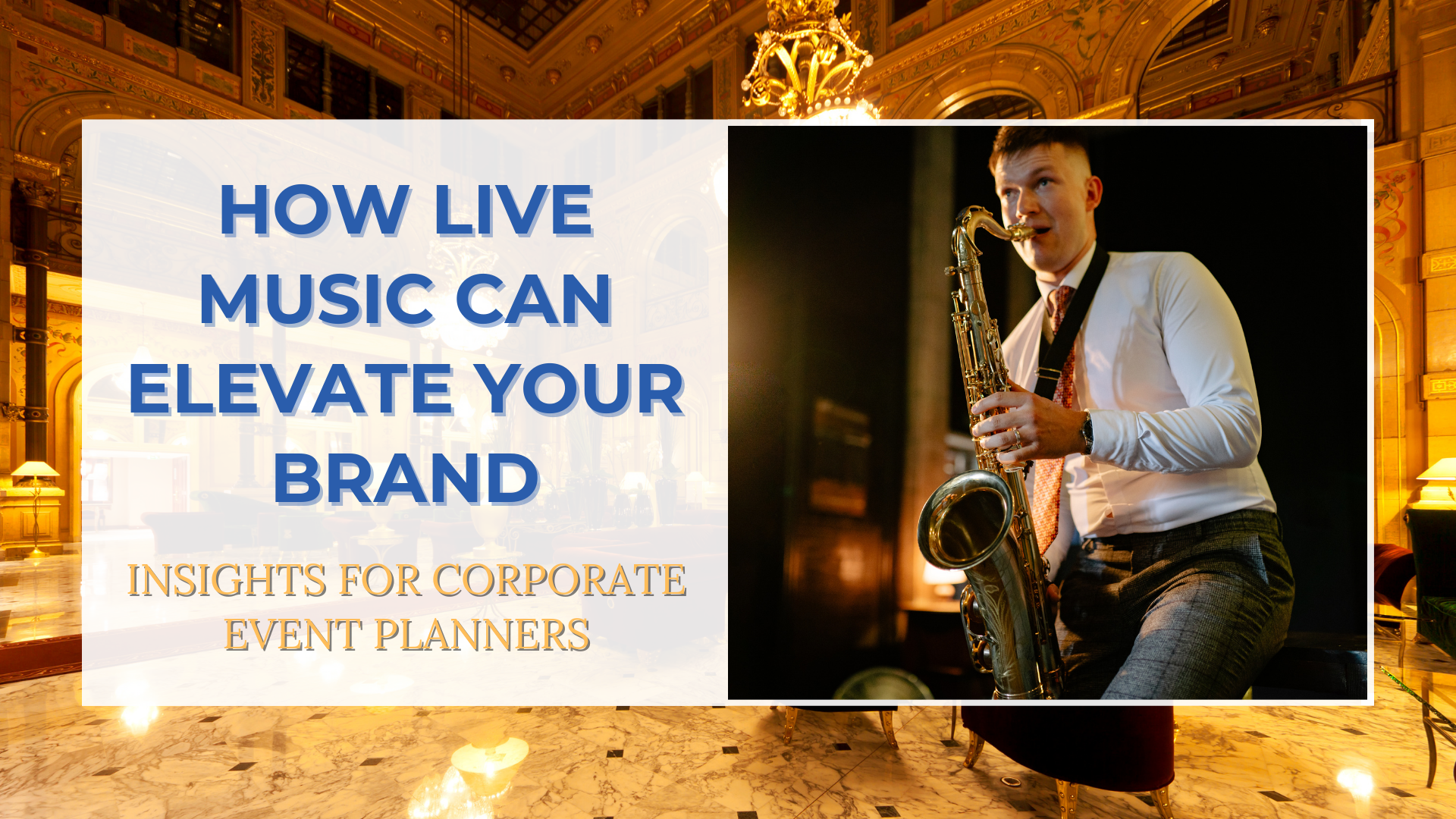The Unspoken Language of Live Music
When you plan a corporate event, you’re not simply managing logistics—you’re curating a moment in time that will represent your brand in the minds of everyone in the room. Every decision you make—the venue’s elegance, the flow of the program, the quality of the catering—speaks in subtle ways about who you are and what your brand values.
But there is one element with a language so universal, so emotionally direct, that it bypasses conscious thought entirely: live music.
Live music is more than entertainment. It’s a living, breathing participant in your event. It senses the mood of the audience and responds in real-time. It can amplify excitement during a product reveal, create intimacy during an award presentation, and reset energy when the room needs a shift.
Unlike a playlist, which plays what was programmed hours or days before, live musicians make split-second decisions that align with your event’s emotional journey. They can slow things down to let a networking conversation flourish, or lift the energy with a well-timed groove that gets guests out of their seats.
This is the art of reading the room—a skill only a human can master. It’s the reason why a perfectly rehearsed setlist still feels different when performed live: because the performance isn’t static, it’s a dialogue between the musicians and your guests.
And this dialogue has the power to:
- Make people feel part of something special rather than just attendees.
- Create moments guests will retell in conversations long after the event.
- Reinforce your brand values in a way no speech or slide deck ever could.
At its core, live music turns corporate formality into shared humanity. It’s not just about filling the air with sound—it’s about shaping how your brand will be remembered.
From Background Sound to Brand Amplifier
At many corporate events, music is treated like wallpaper—pleasant, but passive. The assumption is that as long as there’s something playing, it’s doing its job. But in the hands of professionals who understand event psychology, music doesn’t just accompany the brand—it amplifies it.
Think of it as emotional branding in real time. Every note becomes a cue. Every change in tempo is a shift in narrative. Every live interaction is an opportunity to pull your guests deeper into the story you want your brand to tell.
Instant Atmosphere
The first few seconds after a guest steps into your event space set the tone for their entire experience. The right music creates that emotional frame—before a word of your keynote is spoken, before your product is revealed.
- At a product launch, high-energy jazz or upbeat fusion signals innovation and momentum.
- At a leadership summit, sophisticated strings or smooth acoustic sets communicate prestige, trust, and confidence.
- At a team celebration, lively funk or soulful classics encourage camaraderie and celebration.
This isn’t just ambiance—it’s mood architecture.
Audience Connection
A playlist is static. Live performers are alive.
Skilled musicians read the room and adapt: slowing things down when the crowd needs breathing space, raising the energy when the mood dips, or pulling out an unexpected classic that brings everyone together.
This real-time responsiveness makes guests feel seen, included, and valued—turning your event from a presentation into a shared moment. When attendees connect emotionally, they connect to the brand hosting the experience.
Sensory Branding
True brand experiences engage multiple senses, and music is one of the most powerful triggers for memory. Your guests won’t just remember what they saw on stage or in your slides—they’ll remember how they felt in the moments you created.
- A soulful ballad during an awards ceremony can make an achievement feel monumental.
- A swelling orchestral build during a product reveal can make the launch feel cinematic.
- A perfectly timed groove during networking can make interactions flow naturally.
These are the sonic signatures that become part of your brand’s DNA. Months or even years later, a guest may hear a similar song and be transported back to your event.
Bottom line: Music at corporate events is not a background element—it’s a brand amplifier. When used strategically, it can define the atmosphere, deepen connections, and leave a lasting emotional imprint that strengthens your brand’s identity long after the event is over.
Live Music as a Strategic Brand Tool
Most corporate events are built around logistics—timelines, seating charts, and speaker schedules. But the most impactful events are built around moments. And nothing creates memorable moments quite like live music that is intentionally aligned with your brand identity.
When leveraged strategically, live performance transforms from “background noise” into a brand asset that speaks directly to your audience.
1. Reinforce Brand Values
Every company has a personality—innovative, bold, sophisticated, traditional—and music can make those values tangible.
- Innovation: Surprise your audience with unexpected arrangements, genre fusions, or modern twists on classics. Imagine a string quartet performing an acoustic version of a trending pop hit during a tech product launch—it instantly signals that your brand is forward-thinking and culturally aware.
- Tradition & Stability: If your brand is rooted in heritage and trust, timeless genres like big band, classical, or jazz standards convey reliability, authority, and refinement. The music becomes a mirror of your company’s legacy.
The key is intentional selection—every note should sound like your brand looks, feels, and aspires to be perceived.
2. Drive Engagement
In today’s attention economy, audience engagement is the real currency. Live performers can spark that engagement in ways pre-recorded music never could.
- Conversations Begin: Guests naturally comment on an impressive solo or unexpected song choice—making networking easier and more organic.
- Social Sharing: When performers interact with the crowd or create surprise moments, guests reach for their phones. Each post, story, or reel they share extends your brand’s reach well beyond the venue walls.
- Longer Attendance: A dynamic live set keeps guests lingering, talking, and connecting—maximizing the event’s networking value and ROI.
This isn’t entertainment for entertainment’s sake—it’s purposeful audience activation.
3. Enhance Perceived Value
High-quality live entertainment signals that your organization invests in details that matter. Guests don’t consciously think, “This brand values quality”—but they feel it.
When your event features polished, world-class musicians, it communicates:
- Excellence is our standard.
- We care about your experience.
- This is a brand worth trusting and remembering.
That subconscious association builds long-term loyalty far more effectively than a marketing brochure ever could.
4. Sensory Branding: Sound as an Emotional Signature
Branding isn’t just visual—it’s multisensory. People may forget what they saw, but they will remember what they felt.
Live music can become part of your emotional brand signature:
- The triumphant brass fanfare as a CEO walks on stage.
- The soft, emotive piano during a recognition speech.
- The high-energy closing set that sends everyone home buzzing.
Over time, these moments can even condition your audience to associate certain emotions—pride, excitement, trust—with your brand. Just as a logo triggers visual recognition, a sound can trigger emotional recognition.
Why Timing and Adaptability Matter
The success of a corporate event is rarely about one single moment—it’s about the flow. Guests may not be able to pinpoint why the evening felt seamless, but they will remember the ease with which it moved from one phase to the next. This is where live music becomes more than background entertainment—it becomes the invisible conductor of the event’s emotional journey.
The Arrival: Setting the First Impression
From the moment guests walk in, they are forming an impression of the brand behind the event. Vibrant, welcoming sounds—whether it’s a soulful vocalist, a bright jazz trio, or a polished string ensemble—create immediate warmth and excitement. The right tempo here isn’t just music, it’s messaging: You’re in the right place. This event matters.
The Mid-Event Shift: Creating Space for Connection
Once the crowd has settled and speeches, presentations, or networking sessions begin, the music should adapt. Warm, ambient tones allow voices to carry, giving people the freedom to engage in conversations without strain. This is the moment where live musicians can subtly read the room—lowering volume when energy dips, adding a touch of rhythm if the room feels too static, or introducing familiar melodies that spark smiles and small talk.
The Finale: Leaving on a High Note
As the evening draws to a close, the energy must rise again—not in a chaotic burst, but in a way that feels like a crescendo to the night’s story. An engaging, uplifting performance here ensures guests leave with the same energy they felt when they arrived, if not more. Whether it’s a power ballad that unites the room or an upbeat groove that has people moving, this is the memory they’ll take with them.
Why Playlists Can’t Compete
An algorithm will keep playing songs on a predetermined tracklist. But it won’t notice that the CEO just delivered an inspiring speech and that the perfect follow-up is a soft, triumphant instrumental to let the moment breathe. It won’t see that the networking floor is buzzing and that a light funk groove could double the smiles in the room.
Live musicians adapt in real time. They feel the pulse of the room and adjust not just what they play, but how they play it—slowing down, picking up, adding intensity, or pulling back to create the perfect emotional pacing. This adaptability creates a rhythm to the event that keeps guests present, engaged, and connected from start to finish.
Creating Moments That Last Beyond the Event
In the world of corporate events, details matter—but it’s the moments that define the experience. Attendees might struggle to recall the exact sequence of a presentation or the wording of a keynote, but they’ll vividly remember that one instant when the atmosphere shifted from ordinary to extraordinary.
It could be the warm, velvety tone of a saxophone echoing through the room during a networking break, drawing everyone into quiet awe. It could be a vocalist holding a note so pure that it silenced the chatter, united the audience in a shared breath, and erupted into applause. These are not just musical moments—they are emotional anchors.
What makes them powerful isn’t just the artistry—it’s their timing. The best moments in live music don’t happen by accident; they are crafted in real time, responding to the mood, energy, and unspoken needs of the audience. When done right, they transcend entertainment and become an extension of the brand’s voice.
These moments ripple outward:
- In boardrooms, where executives recall “that incredible band” as a highlight of the conference.
- On social media, as attendees share clips and photos, giving the brand organic reach.
- In personal conversations, where guests retell the story with genuine enthusiasm, embedding the brand into their own narratives.
This is where live music delivers a unique form of brand stickiness. It doesn’t just make people enjoy the event—it makes them feel something they associate with your brand. In a marketplace where impressions are fleeting, those emotional imprints are priceless.
Because when people remember how they felt, they remember who made them feel that way. And that’s when your event stops being an evening on a calendar… and becomes part of someone’s personal history.
The Competitive Edge for Corporate Event Planners
In a crowded market, every corporate event planner is chasing the elusive “wow” factor—the element that makes their event not just run smoothly, but stand out in memory. Budgets, themes, and venues can vary, but one truth remains constant: guests rarely remember the food or the floral arrangements in vivid detail. What they remember is how the event made them feel.
This is where live music has a unique advantage. It’s not just a background feature—it’s a multi-sensory, interactive element that can adapt in real time, infuse emotion into key moments, and subtly reinforce the brand’s values without a single word spoken.
Elegance: The presence of professional musicians signals quality and care. It communicates that no detail has been overlooked and that the event—and by extension, the brand—is worth investing in.
Flexibility: Live performers can pivot instantly—adjusting tempo, style, and mood to match the evolving energy of the room. This adaptability ensures your event flows seamlessly, even when the unexpected happens.
Emotional Impact: A live performance can elevate a brand’s perception far beyond any stage set or printed program. It turns brand messaging into a lived experience—something attendees can feel in their bones and carry with them long after the night is over.
When you integrate live performance as a strategic element—not as an afterthought—you shift your event from functional to unforgettable. You create shared moments of connection that not only delight your guests but also position the brand you’re representing as a leader in sophistication, innovation, and guest experience.
In an industry where planners are under constant pressure to deliver results, this is your competitive edge: live music that transforms an event into a story worth telling.


.png)














